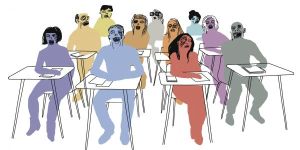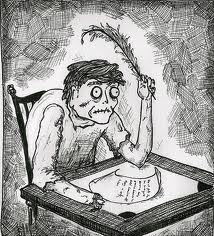Zombies stumble into my class all the time. They tend to be friendly but a little lost, uncertain whether they belong in a fiction workshop. They stare blankly when I explain that the course is focused on “literary” fiction, a species of writing they’ve heard of but only sporadically consumed.
It’s not an easy term to digest. Adam Brooke Davis, in his recent essay “No More Zombies!,” divides “the playfulness that is above seriousness from the drivel that is below it” by banning all “alt-worlding” from his advanced writing workshop and requiring his students to write about “real environments with real people, facing [real] problems.” So “literary” is narrative realism, and everything else is genre (sci-fi, fantasy, horror). Those are pretty much the definitions the publishing industry has been using for decades.
It sounds good, but when I open up a collection of O. Henry Prize-winning stories I find a range of alternate worlds. They involve androids, a village on the back of a whale, and a giant square from space that slowly crushes a town. If I reach to my next shelf, I can pull down a dozen top-tier literary journals that include equally nonrealistic stories, all quite serious and drivel-free. The range of narrative realism in the same issues is serious and drivel-free too. A story’s setting, real or speculative, predicts nothing.
Yet Davis bemoans the influence of pop culture, believing that all the alt-worlds infecting film, TV, and popular literature have mutated his students into lazy zombies instead of disciplined writers. If so, it’s got nothing to do with “alt-worlding”—all fiction writing is alt-worlding. There is no such thing as a work of fiction that takes place in the real world. Stories exist solely in words. That’s an unbelievably obvious fact, but even creative-writing professors can lose track of the implications.
A work of narrative realism is no closer to being “real” than a story about vampires, superheroes, or anthropomorphic chipmunks. By “real,” we usually mean “familiar,” sometimes lazily so. If a first sentence describes a pickup truck grinding over gravel, rather than a hovercraft quivering above landing lights, we perceive the story as existing “here” and “now,” not in some other place and time. The implied world is a ready-made. Instantly recognizable environments, Davis implies, force students to focus on more important story elements.
Sometimes that’s true. But if handed a choice, I will sooner read a student draft that takes place on a distant planet in a far-flung future than a story set in a campus dorm last weekend. Neither setting is intrinsically better, but even the most experienced writer needs some psychic (and so probably physical and temporal) distance to transform real experience into “realistic” literature. When a genre draft is bad, however, it’s probably because the writer has been consumed by the formula. That’s an easier problem to fix.
When I tell students they can write anything as long as it’s “literary,“ I define the term as “character-driven.” Nonliterary fiction, I explain, is plot-driven and includes any story in which characters act according to the needs of the plot rather than from an artfully crafted illusion of psychologically complex motivation. Plot is still important—without it, the best you can hope for is a beautifully chiseled character study that lacks any page-turning momentum. But, I ask, is the plot serving the characters, or are the characters serving the plot?
It’s not a perfect (or particularly original) definition, but it gets the job done. When I faced down my first zombie in a workshop, I didn’t flinch. I also didn’t chuckle and dismiss the story as a warm-up. I critiqued it the same way I would critique a piece of narrative realism. And, when the student turned in a revision, the story had transformed into realism. The zombies didn’t vanish, but the characters’ genre-determined behaviors did. Alternate worlds aren’t the only stories choked with clichés, but they do have more overtly defined sets of formula expectations. And that makes them easy to gut. Just ask one question: Is the world serving the characters, or are the characters serving the world?
Davis’s zombie ban sparked some outrage from fellow writing professors, but I agree with Lesley Wheeler, who wrote in her literary blog that Davis, despite the weaknesses of his argument, “seems like a dedicated teacher who wants to do the best he can by his creative-writing students.”
I’ll go a step further. Not only do Davis and I have the same good intentions, he and I want to help our students produce exactly the same kind of story. Davis confuses it with “real environments,” but that’s a surface element. He wants depth. He wants psychological realism. It doesn’t matter if the characters are androids, elves, or mere “humans”—as long they behave humanly. Does the zombie stumble through its life in all the messy and horrific ways readers recognize from their own lives? If so, the character is “real,” whether zombified or not.
“Literary” stories require readers to infer complex inner lives for artificially real characters. I won’t deny the pleasures of formula and its plot-beholden characters, but they’re nothing compared to the joys of eating an imaginary brain. Open a skull and explore all the flavors. I demand all my students to be zombies.


